Having a baby is akin to having a human alarm clock. Both wake you up with sudden noise, but what do you do when your baby or toddler wakes before 6:00 am ready to start their day? Sure, the average baby wakes ‘early’ by most adult standards but any time before 6:00 am is too early by anyone’s standards!
A cheerful, refreshed, and ready-to-go child who wakes at 6:00 or 7:30 a.m. is reasonable. That’s a biologically appropriate time for babies and small children to wake, and if this is the case, you may have to live with it for a while. If it’s earlier than that, you’ll need to figure out why they are up so early and what you can do about it.
What’s a Reasonable Wake up Time in the Morning?
A cheerful, refreshed, and ready-to-go child who wakes at 6:00 or 7:30 a.m. is probably normal. That’s a biologically appropriate time for babies and small children to wake, and if this is the case, you may have to live with it for a while. If it’s earlier than that, then perhaps you can change part of your routine to get your child (and you) a few more hours of sleep.
RELATED: Baby and Child Sleep: Sample Schedules From 6 Months to Preschool
Why Is My Child Rising Early?
Late Bedtime
Sleep begets sleep! It’s not an “old wive’s tale”, it’s true. Many parents are shocked to find out that their child’s natural bedtime is likely between 7:00 p.m. and 8:00 p.m. for the first 10 years of life! If your baby’s bedtime is well beyond this window, sleep in the night could be disrupted and can lead to early rising, not to mention night terrors. Watch your child’s sleep cues and get them to bed earlier which can help them sleep better at night.
Along the same lines, taking too few or too short of a nap can also cause early rising. Believe it or not nap deprivation makes your baby or child overtired, leading to an overtired child at bedtime. Overtiredness, in turn, can cause more night wakings and early rising. Its not logical but it’s true!
Review your child’s sample schedule to see if you may need to adjust your nap schedule in timing and amount of sleep your child needs on average during the day.
Too Long a Wakeful Window
The average wakefulness window between afternoon nap and bedtime for most toddlers is around 4 hours. It’s less for younger babies. Check to see what time your child’s last nap of the day ends, and make sure there is an appropriate amount of time between the end of the nap and bedtime. Again, an overtired baby at bedtime will not make for a better night’s sleep.
RELATED: Everything You Need to Know About Baby and Toddler Naps
Your “Drowsy But Awake” is Too Drowsy
It’s an oldie but a goodie — make sure that you are putting your baby in his crib drowsy but awake. This means that you need to be aware of how sleepy he is getting during his bedtime routine, and perhaps make some adjustments.
To ensure that your child is ‘awake enough’, put him in the crib when he is still alert, and will understand that he’s being put in his bed. If you are putting your child into a bed too drowsy or perhaps laying down with him, he won’t learn to resettle himself when he wakes during the night and wonder why you are not there.
Too Bright in the Morning
If too much light is coming into your baby’s room in the early morning consider purchasing room-darkening or blackout shades to truly block the light. If external noise such as dogs, garage trucks, a parent leaving early for work, try a white noise machine.
Hungry
For some babies, waking early may be a sign of hunger. If your baby is under 8 months of age, and you think that this could be the source of your early rising issue, you may want to build one feeding into your night plan. Your child may need a “dream feed” around 10 or 11 p.m., in order to stay full until wake-up time. Stay as quiet as possible in a dimly lit room so that he is barely awake for this late night feeding. Review your baby’s feeding schedule with your doctor.

Rule Out Medical Issues
You may be surprised to learn that a common cause of early rising is undiagnosed sleep apnea, along with allergies, and GERD. If you hear your child snoring, or gasping in their sleep, please do not ignore the symptoms and see your pediatrician. Obstructive sleep apnea, asthma, or allergies can make breathing, and therefore sleep, difficult.
Use The Shuffle
If all else fails, revert to The Sleep Lady Shuffle early in the morning.
Treat the early rising issue as you would normal night waking, with the exception that you will only be ‘shuffling’ until 6:30 a.m. If your child still has not fallen asleep, leave the room for 30 to 60 seconds, and then return, using dramatic wake up to help your child differentiate between sleep time and awake time.
Use Dramatic Wakeup
Some children need a definite line between sleep time and wake up time. “Dramatic Wake-Up” is great for that. When you go in every morning, make a big deal about saying “Good Morning.” This will send the message that you are getting her up because it’s morning, not because she is crying, or refusing to go back to sleep.
Don’t Give Up!
Don’t give up if you feel that the early rising problem isn’t resolving itself. Be sure that you are adjusting your child’s schedule — including moving to an earlier bedtime if necessary — to fit with their wake-up time so that you don’t end up with an overtired baby at bedtime.
Changing the pattern of early rising is not easy. Parents will have to be very consistent and patient to break the habit
A Wake-Up Clock for Toddlers
You can introduce older toddlers and children to a “wake-up clock.” This especially helps with children who like to be independent, but still need guidance about appropriate wake times. You simply set the clock to the time that is appropriate for wake-up, and explain to them that they must stay in bed until the clock lights up, or plays music.
While they are learning to stay in bed, treat early rising like a night waking. Go into their room and remind them that their wake up clock is not on and that they must stay quietly in bed. . Use The Shuffle until their wake up clock goes off. Then you can go back in and say “Your wake up clock is on or light is on. Now its time to get up! ” You must do this repeatedly and strictly for a few weeks before it really “sinks in”. Remember if you don’t take the clock seriously and get them up before its gone off or turned on – your child won’t take it seriously either .
We Love Ooly
We love using toddler clocks with sleep coaching so we partnered with Ooly. Ooly is the first app-connected clock designed to help children understand bedtime and wake-up time. Compatible with iOS and Android, the Ooly remembers its settings forever and uses color and light to cue your child at bedtime and in the morning.
Features
- Easy to set up
- Totally customizable
- USB rechargeable
- Light and sound indicate wake-up time
- “Ultra low light” mode promotes sleep, “Blue blocker” mode prevents disruptive lighting at night
- Child-friendly, easy-to-clean, Bluetooth Low-energy equipped, BPA-Free
- Soft, reassuring glow acts as a nightlight and reassuring presence
- Follows you to use it at Grandma’s or on vacation because it remembers its setup even without your device around
- No buttons for your curious child to push
- “Lantern mode” can accompany your child to the bathroom at night
- Last minute schedule changes are easy with your phone or tablet and the app








